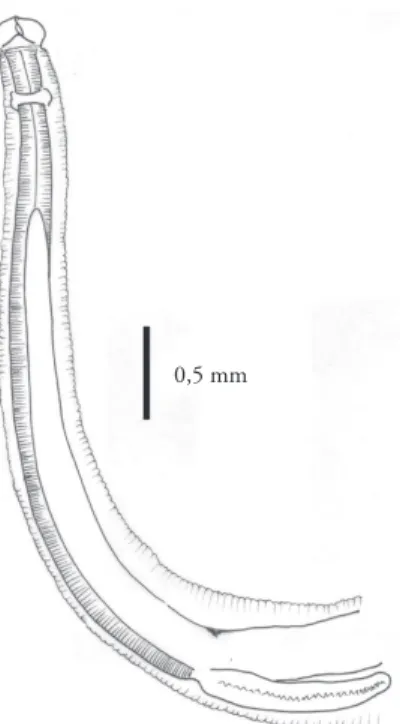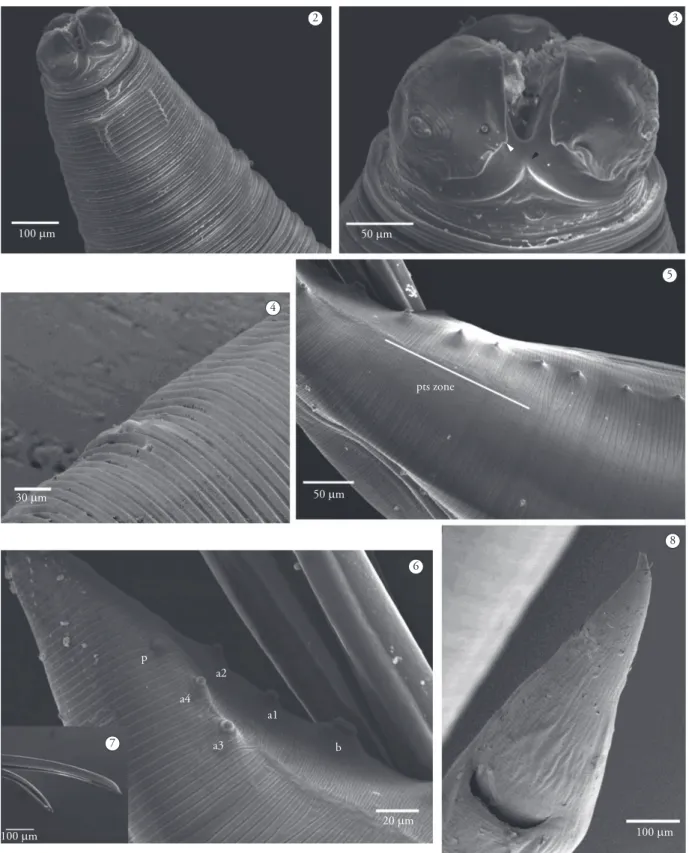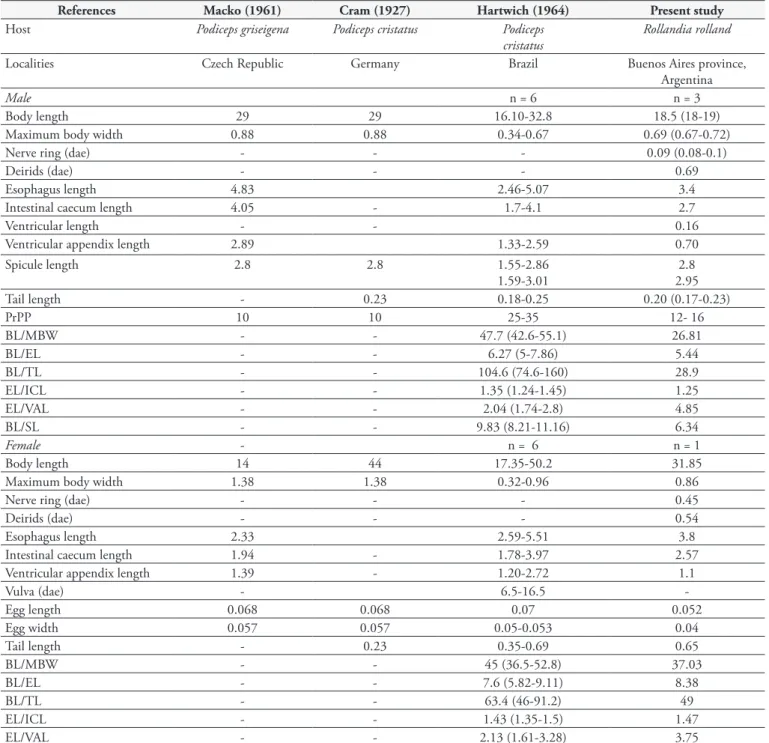www.cbpv.com.br/rbpv
Contracaecum ovale
(Nematoda: Anisakidae)
from
Rollandia rolland
Quoy & Gaimard 1824
(Aves, Podicipedidae) in Argentina
Contracaecum ovale
(Nematoda: Anisakidae) de
Rollandia rolland
Quoy & Gaimard
1824 (Aves, Podicipedidae) na Argentina
Noelia Adelina Galeano1; Ruben Daniel Tanzola1*
1Laboratorio de Patología de Organismos Acuáticos, Departamento de Biología, Bioquímica y Farmacia, Universidad Nacional
del Sur – UNS, Bahía Blanca, Argentina
Received April 1, 2011 Accepted May 29, 2011
Abstract
Necropsy on 15 specimens of white-tufted grebe, Rollandia rolland, caught in the Mar Chiquita and Chascomús lagoons (Buenos Aires province), revealed the presence of Contracaecum ovale (Linstow, 1907). This nematode shows a marked specificity for podicipediform birds. The specimens were identified from morphological study on features such as cephalic and esophageal structures and caudal papillae, using both optical and scanning electron microscopy. This is the first record of C. ovale parasitizing R. rolland in Argentina.
Keywords: Contracaecum ovale, Nematoda, Rollandia rolland, Podicipedidae.
Resumo
Necropsia de 15 espécimes de mergulhão-de-orelha-branca, Rollandia rolland, coletados nas lagoas Mar Chiquita e Chascomús (Província de Buenos Aires), revelou a presença de Contracaecum ovale (Linstow, 1907). Esse nematóide tem uma marcada especificidade pelas aves podicipediformes. Os espécimes foram identificados a partir de características, tais como estruturas morfológicas cefálicas e esofágicas e papilas caudais, utilizando-se microscopia óptica e microscopia eletrônica de varredura (MEV). Esse é o primeiro registro de C. ovale parasito de R. rolland na Argentina.
Palavras-chave: Contracaecum ovale, Nematoda, Rollandia rolland, Podicipedidae.
Contracaecum ovale (Linstow, 1907) is an ascaridoid nematode with pronounced specificity for podicipediform hosts. It was first described in Podiceps cristatus from Germany. Cram (1927) described this species in the same host and Baylis (1939) included it in a list of the parasites of British birds. Subsequently, Mozgovoi (1953) described it briefly in P. cristatus from Russia. Vuylsteke (1953) recorded C. ovale in P. ruficollis capensis from the Congo. Macko (1961) described it in P. griseigena and P. nigricollis from the Czech Republic. The only previous record from the Neotropical region is that of Hartwich (1964) in Podilymbus podiceps in Brazil. Stock and Holmes (1987) cited C. ovale as a member of the parasite communities of P. grisegena, P. nigricollis and P. auritus in Canada. To the best of our knowledge, some details of the external morphology of this species remain unknown.
This note reports C. ovale in the white-tufted grebe, Rollandia rolland, for the first time in Argentina. White-tufted grebes are the most common grebe in lakes and lagoons throughout Argentina, from Misiones to Tierra del Fuego (STORER, 1967; FJELDSA, 2004). In this paper, C. ovale is described using optical microscopy and scanning electron microscopy (SEM).
The helminth specimens, which belong to the author’s personal collection, were obtained between 1983 and 1985 from 15 individuals of R. rolland (Aves: Podicipediformes) that were killed using a shotgun (with permission for scientific hunting granted by the Fauna Directorate, Ministry of Agrarian Affairs, Government of the Province of Buenos Aires) in the Mar Chiquita lagoon (n = 12) (37° 46’ S and 57° 27’ W) and Chascomús lagoon (n = 3) (35° 40’S and 58° 00’ W) in Buenos Aires province. Once in the laboratory, the birds were dissected and nematodes were collected from the stomach and fixed and stored in 5% formalin. Some specimens were cleared in lactophenol and examined by means of optical microscopy. Drawings were made with the aid of a camera lucida. Measurements, in millimeters, were expressed as *Corresponding author: Ruben Tanzola
Laboratorio de Patología de Organismos Acuáticos, Departamento de Biología, Bioquímica y Farmacia, Universidad Nacional del Sur,
San Juan, 670, CP 8000, Bahía Blanca, Buenos Aires, Argentina
e-mail: rtanzola@uns.edu.ar
144 Galeano, N.A.; Tanzola, R.D. Rev. Bras. Parasitol. Vet.
the mean followed by the range in parentheses. Other specimens, fixed in 5% formalin were dehydrated in acetone, dried using the CO2 critical point method and observed and photographed using scanning electron microscopy (SEM) (Evoup/LEO). The spatial location of the male’s papillae was described in accordance with Fagerholm (1991). The voucher specimen was deposited in the Helminthological collection of the Museo de la Plata, Argentina (nº MLP 6313). The measurements made in this study and those given by previous authors are presented in Table 1. Morphological details are shown in Figures 1-8.
The entire body of C. ovale is transversally striated (Figure 2). The lips are mostly oval in shape with two small auricles (Figure 3). There are two large double papillae on the dorsal lip and one on each ventrolateral lip (Figure 3) and, additionally, an amphid is present on each ventrolateral lip. The interlabia were triangular in shape and shorter than the lips (Figure 3). The deirids were inconspicuous and button-shaped (Figure 4)
Measurements on male specimens (n = 3): body length 18.5 (18-19); maximum body width 0.69 (0.67-0.72); distance from anterior end to nerve ring and deirids 0.09 (0.08-0.1) and 0.69, respectively; esophagus length (n = 1) 3.4; intestinal caecum length (n = 1) 2.7; ventriculus length (n = 1) 0.16; ventricular appendix length (n = 1) 0.70; spicules of equal length, reaching almost half of the body; spicule length (n = 1) 2.87; and tail length 0.20 (0.17-0.23). The caudal extremity was conical, bearing 12-16 pairs of precloacal papillae. The precloacal transverse stria (“pt”) zone included three pairs of precloacal papillae (Figure 5). There was one double paracloacal papilla (sensu FAGERHOLM, 1991) and five pairs of single postcloacal papillae: two subventral pairs, two sublateral pairs (“laterodorsal” sensu HARTWICH, 1964) and one pair of phasmids at the end (Figure 6).
The distal spicule tip was short and pointed; the length of the free distal end was longer than the spicule width (0.013 versus 0.011). Following Fagerholm’s approach (1989), the measurements of the distal end of the spicule (n = 1) in µm were: A-B: 12.6; A-C: 16.3; A-D: 35.6; Dist B*-B°: 12.6; E-F: 8.2; E-H: 23.7; E-I: 30.4; and F-G: 11.1 (Figure 7)
Measurements on female specimen (n = 1): body length 31.85; maximum body width 0.86; distance from anterior end to nerve ring and deirids 0.45 and 0.54 respectively; esophagus length 3.8; intestinal caecum length 2.57; ventricular appendix length 1.1; vulva in anterior half of the body and tail length 0.65 (Figure 8).
The information provided by Mozgovoi (1953) coincides with that of Cram (1927) and so it was not included in Table 1.
The morphology and dimensions of our specimens were concordant with previous reports (CRAM, 1927; MOZGOVOI, 1953; MACKO, 1961; HARTWICH, 1964). Although the complexity of the lips was best discerned by Hartwich (1964), the ultrastructural observations made in the present report showed two small auricles and that the interlabia was one third of the lip height and triangle-shaped, in conformity with this author’s findings. Fagerholm (1989) considered that the length of the spicules, morphology of the distal end of the spicule and number and distribution of caudal papillae in the males were other good taxonomic criteria. The number and distribution pattern of the caudal papillae agree with those of
previous descriptions (CRAM, 1927; HARTWICH, 1964), but the details of the distal end of the spicules at ultrastructural level are described for the first time in the present paper. Macko (1961) and Cram (1927) reported 10 pairs of precloacal papillae, but Hartwich (1964) reported 29-35 pairs of precloacal papillae. Previous authors reported a wide range of intraspecies variation with regard to the number of precloacal papillae in anisakids: 60-81 pairs in C. osculatum (FAGERHOLM, 1989), 23 - 49 in C. ogmorhini (FAGERHOLM; GIBSON, 1987) and 44 - 61 in Terranova galeocerdonis (TANZOLA; SARDELLA, 2006). For this reason, we can accept that the differences observed in relation to Hartwich’s specimens may correspond to such intraspecies variation.
In Argentina, several species of Contracaecum have been reported parasitizing birds from freshwater, brackish water and marine ecosystems. Contracaecum microcephalum (Rudolphi, 1809) has been described parasitizing the Ardeidae species Ardea cocoi Linnaeus, Egretta alba (Gmelin, 1789), Nycticorax nycticorax (Gmelin, 1789) and Casmerodius albus egretta (Lineé, 1766) in Buenos Aires province and C. multipapillatum has been described parasitizing E. alba (BOERO; LED, 1971; NAVONE et al., 2000). Contracaecum travassosi (Gutierrez, 1943) has been described in Phalacrocorax atriceps (= P. albiventer) (Lesson, 1831). Garbin et al. (2007) redescribed C. pelagicum (Johnston and Mawson, 1942) in Thalassarche melanophris Temminck and Spheniscus magellanicus Foster. In the latter host, Pazos et al. (2003) found C. spheniscus Boero and Led (1970) and C. chubutensis in P. atriceps King (GARBIN et al., 2008). The last three species came from Chubut province in Patagonia. This is the first record of C. ovale in R. rolland in Argentina, and it confirms the marked specificity of this species for podicipediform birds.
146 Galeano, N.A.; Tanzola, R.D. Rev. Bras. Parasitol. Vet.
Table 1. Comparative morphometric data (in mm) on Contracaecum ovale.
References Macko (1961) Cram (1927) Hartwich (1964) Present study
Host Podiceps griseigena Podiceps cristatus Podiceps
cristatus
Rollandia rolland
Localities Czech Republic Germany Brazil Buenos Aires province,
Argentina
Male n = 6 n = 3
Body length 29 29 16.10-32.8 18.5 (18-19)
Maximum body width 0.88 0.88 0.34-0.67 0.69 (0.67-0.72)
Nerve ring (dae) - - - 0.09 (0.08-0.1)
Deirids (dae) - - - 0.69
Esophagus length 4.83 2.46-5.07 3.4
Intestinal caecum length 4.05 - 1.7-4.1 2.7
Ventricular length - - 0.16
Ventricular appendix length 2.89 1.33-2.59 0.70
Spicule length 2.8 2.8 1.55-2.86
1.59-3.01
2.8 2.95
Tail length - 0.23 0.18-0.25 0.20 (0.17-0.23)
PrPP 10 10 25-35 12- 16
BL/MBW - - 47.7 (42.6-55.1) 26.81
BL/EL - - 6.27 (5-7.86) 5.44
BL/TL - - 104.6 (74.6-160) 28.9
EL/ICL - - 1.35 (1.24-1.45) 1.25
EL/VAL - - 2.04 (1.74-2.8) 4.85
BL/SL - - 9.83 (8.21-11.16) 6.34
Female - n = 6 n = 1
Body length 14 44 17.35-50.2 31.85
Maximum body width 1.38 1.38 0.32-0.96 0.86
Nerve ring (dae) - - - 0.45
Deirids (dae) - - - 0.54
Esophagus length 2.33 2.59-5.51 3.8
Intestinal caecum length 1.94 - 1.78-3.97 2.57
Ventricular appendix length 1.39 - 1.20-2.72 1.1
Vulva (dae) - 6.5-16.5
-Egg length 0.068 0.068 0.07 0.052
Egg width 0.057 0.057 0.05-0.053 0.04
Tail length - 0.23 0.35-0.69 0.65
BL/MBW - - 45 (36.5-52.8) 37.03
BL/EL - - 7.6 (5.82-9.11) 8.38
BL/TL - - 63.4 (46-91.2) 49
EL/ICL - - 1.43 (1.35-1.5) 1.47
EL/VAL - - 2.13 (1.61-3.28) 3.75
dae = distance from anterior end; PrPP: precloacal papilla pairs; BL/MBW: body length/maximum body width ratio; BL/EL: body length/esophagus length ratio; BL/TL: body length/tail length ratio; EL/ICL: esophagus length/intestinal caecum length ratio; EL/VAL: esophagus length/ventricular appendix length ratio; BL/ SL: body length/spicule length ratio.
References
Baylis J. Further records of Parasitic worm from British Vertebrates.
A n n M a g Na t H i s t 1 9 3 9 ; 4 : 4 7 3 - 4 9 8 . h t t p : / / d x . d o i . org/10.1080/00222933908527013
Boero JJ, Led JE. El parasitismo de la fauna autoctona. V. Los parasitos de las aves argentinas. Analect Vet 1971; 3(1-3): 91-103.
Boero JJ, Led JE, Brandetti E. Algunos parásitos de la avifauna argentina.
AnalectVet 1972, 4(1): 17-25.
Cram E. Birds parasites of nematode suborders Strongylata, Ascaridata and Spirurata. Bull US Natl Mu 1927; 140: 155-156.
Fagerholm HP. Intra-specific variability of the morphology in a single population of the seal parasite Contracaecum osculatum (Rudolphi) (Nematoda, Ascaridoidea), with a redescription of the species. Zool Scr 1989; 18(1): 33-41. http://dx.doi.org/10.1111/j.1463-6409.1989. tb00121.x
Fagerholm HP, Gibson DI. A redescription of the pinniped parasite
Contracaecum ogmorhini (Nematoda, Ascaridoidea), with an assessment of its antiboreal circumpolar distribution. Zool Scr 1987; 16(1): 19-24. http://dx.doi.org/10.1111/j.1463-6409.1987.tb00047.x
Fjeldsa J. The Grebes: Podicipedidae. New York: Oxford University Press; 2004.
Garbin LE, Navone GT, Diaz JI, Cremonte F. Further study of
Contracaecum pelagicum (Nematoda: Anisakidae) in Spheniscus magellanicus (Aves: Spheniscidae) from Argentinean coasts. J Parasitol
2007; 93(1): 143-150. PMid:17436954. http://dx.doi.org/10.1645/ GE-875R1.1
Garbin LE, Diaz JI, Cremonte F, Navone GT. A new anisakid species parasitizing the imperial cormorant Phalacrocorax atriceps from the north Patagonian coast, Argentina. J Parasitol 2008; 94(4): 852-859. PMid:18837571. http://dx.doi.org/10.1645/GE-1369.1
Hartwich G. Die Typen Parasitischer Nematoden in der Helminthen-Sammlung des Zoologischen Museums in Berlin. I. Ascaridoidea. Mitt Zool Mus 1964; 40: 1-53.
Macko JK. Niektoré pozorovania o premenlivosti druhu Contracaecum (Contracaecum) nebli Karokhin, 1949. Biol Brat 1961; 16(10): 740-748.
Mozgovoi AA. Ascaridata of animals and man and the diseases caused by them. Moscow: Akademiya Nauk. Osnovy Nematodologii; 1953.
Navone GT, Etchegoin JA, Cremonte F. Contracaecum multipapillatum
(Nematoda: Anisakidae) from Egretta alba (Aves: Ardeidae) and comments on the species of this genus in Argentina. J Parasitol 2000; 86(4): 807-810. PMid:10958460.
Pazos GE, Laurenti S, Diaz JE. Helmintofauna del pingüino de Magallanes (Spheniscus magellanicus) en Península Valdés, Provincia del Chubut. Resultados Preliminares. Hist Nat 2003; 2(10): 85-94.
Stock TM, Holmes JC. Host specificity and exchange of intestinal helminths among four species of grebes (Podicipedidae). Can J Zool
1987; 65(3): 669-676. http://dx.doi.org/10.1139/z87-104
Storer RW. Observations on Rolland´s Grebe. El Hornero 1967; 10: 339-350.
Tanzola RD, Sardella NH. Terranova galeocerdonis (Thwaite, 1927) (Nematoda: Anisakidae) from Carcharias taurus (Chondrichthyes: Odontaspididae) off Argentina, with comments on some related species.


